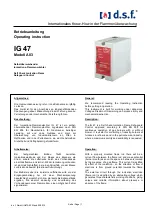
12 Specifications
244
When electromagnetic interference (EMI) is encountered, for example, if you can hear spurious noises
on the fetal monitor's loudspeaker, attempt to locate the source. Assess the following:
•
Is the interference due to misplaced or poorly applied transducers? If so, re-apply transducers
correctly according to directions in this book, or in the Instructions for Use accompanying the
accessory.
•
Is the interference intermittent or constant?
•
Does the interference occur only in certain locations?
•
Does the interference occur only when in close proximity to certain medical electrical equipment?
Once the source is located, there are a number of things that can be done to mitigate the problem:
1
Eliminating the source. Turn off or move possible sources of EMI to reduce their strength.
2
Attenuating the coupling. If the coupling path is through the patient leads, the interference may be
reduced by moving and/or rearranging the leads. If the coupling is through the power cord,
connecting the system to a different circuit may help.
3
Adding external attenuators. If EMI becomes an unusually difficult problem, external devices such
as an isolation transformer or a transient suppressor may be of help. Your service provider can be
of help in determining the need for external devices.
Where it has been established that electromagnetic interference is affecting physiological parameter
measurement values, a physician, or a suitably qualified person authorized by a physician, should
determine if it will negatively impact patient diagnosis or treatment.
System Characteristics
The phenomena discussed above are not unique to this system, but are characteristic of fetal patient
monitoring equipment in use today. This performance is due to very sensitive high gain front end
amplifiers required to process the small physiological signals from the patient. Among the various
monitoring systems already in clinical use, interference from electromagnetic sources is rarely a
problem.
Electromagnetic Emissions and Immunity
The EMC standards state that manufacturers of patient-coupled equipment must specify immunity
levels for their systems. See Tables 1 to 4 for this detailed immunity information. See Table 5 for
recommended minimum separation distances between portable and mobile communications
equipment and the product.
Immunity is defined in the standard as the ability of a system to perform without degradation in the
presence of an electromagnetic disturbance.
Caution should be exercised in comparing immunity levels between different devices. The criteria used
for degradation are not always specified by the standard, and can therefore vary with the manufacturer.
In the table below, the term "device" refers to the Avalon FM20/30/40/50 fetal monitor together with
its accessories. The table gives details of the electromagnetic emissions, and how these are classified,
Содержание Avalon FM20
Страница 2: ......
Страница 6: ...6 ...
Страница 38: ...3 Installation Instructions 38 ...
Страница 46: ...4 Theory of Operation 46 ...
Страница 145: ...10 Repair and Disassembly 145 7 The top cover assembly is now separated from the bottom housing assembly ...
Страница 154: ...10 Repair and Disassembly 154 10 Take the new rear housing cover and place it in the position shown ...
Страница 155: ...10 Repair and Disassembly 155 11 Put the two halves of the display assembly together as shown ...
Страница 163: ...10 Repair and Disassembly 163 4 Turn over the top cover assembly and place it top down on a cloth or other soft surface ...
Страница 167: ...10 Repair and Disassembly 167 10 Remove the four screws holding the recorder chassis ...
Страница 169: ...10 Repair and Disassembly 169 12 Remove the RFI bracket 13 Lift out the recorder chassis ...
Страница 200: ...10 Repair and Disassembly 200 2 Remove the screws holding the metal shield 3 Remove the shield ...
Страница 254: ...12 Specifications 254 ...
Страница 259: ......
Страница 260: ...Part Number 453564541271 Published in Germany 11 14 453564541271 ...
















































